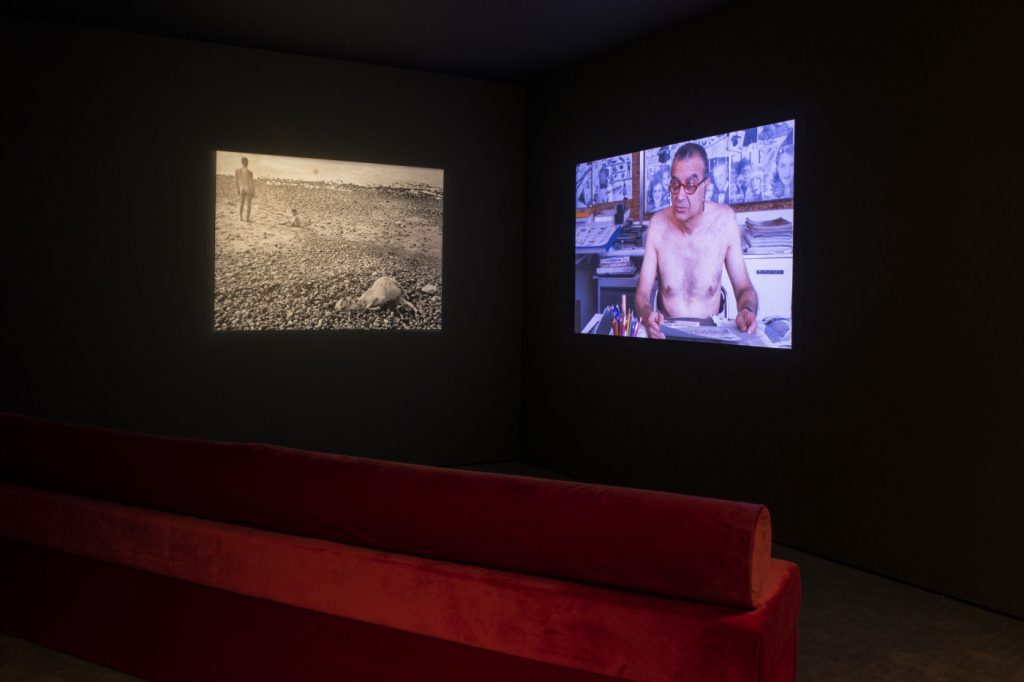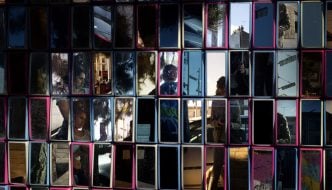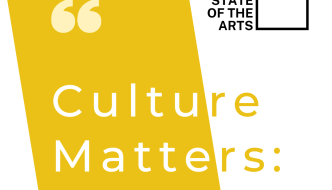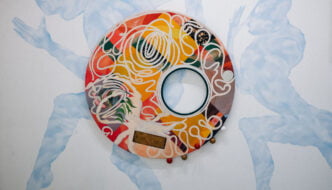
Agnès Varda ‘Ulysse’, Courtesy of FACT Liverpool
The first time I saw Agnès Varda’s 1954 photograph Ulysse, emphatically projected on the far wall of a dark little room in FACT Liverpool, I thought it was one of the most beautiful and captivating images I’d ever seen.
The photograph is at once startling and oddly sober, almost matter of fact: in black, white and grey – death, life and in-between. A man, a boy and a dead goat are the subjects, with the goat dominating the foreground, splayed on the erratically textured pebbles of a beach. The man stands naked staring out to sea, while the boy, the smallest but somehow most entrancing figure in the tableau, sits beside the man, gazing back at the corpse of the goat. The picture seems to represent everything – a history and a summary conjured through three figures, a story of bodies.
And there’s a story behind the story. Projected on the adjacent wall of the installation plays Varda’s 1982 short documentary film, also titled Ulysse, which explores the fascinating personal and historical contexts of the photograph, as well as providing an insight into Varda’s artistic outlook and development. The film begins with a still shot of the photograph, temporarily identically projected on two walls, with only slight differences in colour separating each artwork, as if reflected in a murky mirror.
The film then cuts to the man in the photograph, Fouli Elia, now an art director of Elle magazine, appearing nonchalantly naked in his office almost three decades on from that day on the beach in 1954. As Varda shows Elia a series of pictures taken around this time, the effect of three decades on the memory become clear, as he is unable to remember the instances and location of the images. He also has a hard time believing the person in the photographs is himself, finding it easier to recognise the shirts and shoes he’s wearing, rather than his own young face. Hinting at the strange and unexpected ways our memories function, this fixation on attire makes Elia’s overt nakedness in the scene seem even more bizarre.
As the film plays I find my eyes are constantly drawn back to the photograph on the adjoining wall. Besides the perfect composition of the three figures, the photograph radiates multiple layers of perceptibility. Even the setting could be viewed interpretatively; depending on your perspective, the sea could be sky, and the shore could be the snowy peak of a mountain, but it’s the ambiguous symbolism of the three figures that really invites the viewer to unravel their own meanings.
At one point in the film Varda compares the goat to a mother, with the man and the boy being the distant father and child. She also goes on to invoke the Ulysses of Homer’s Odyssey, comparing the character to the naked man who stares, perhaps longingly, out to the unknowable ocean. But amongst all this speculation the image retains its enigma, a mystery even the artist can’t solve, though her film does illuminate a poignant and complex background.
About halfway through the 20 minute film the gentle face of man appears on screen, his jumper tied casually around his shoulder. It’s revealed that this is the Ulysse from the photograph, now in his thirties. Smiling coyly, he answers Varda’s questions as if completely removed from his childhood, while the looming presence of his mother hovers behind him staring directly into camera, adding to the unreality of the piece, toying with the line between art and life.
Earlier in the film Varda describes how she looked after Ulysse while his parents were subject to government persecution due to their political dissonance. This period in their lives was made even more difficult due to a condition Ulysse suffered from as a boy which prevented him from being able to walk, hence his limp sitting pose in the photograph. All these intricacies amplify the emotion of the picture and the story behind it, but still the films comes little closer to capturing the true essence of that bold image.
“Like water, time never stops flowing,” Varda proffers in her melancholic voiceover, and the film is certainly as much about time and memory as it is about the photograph, and through this intermingling the story is revealed. This context enhances the experience of the photograph in many ways, but I did end up missing the beguilement I felt upon first witnessing the image in its contextless haze. I do not regret seeing the film, it is a great work in and of itself, but I do think there are some artworks that thrive on the vagueness that surrounds them, a disconnection from the source. Knowledge is a double-edged-sword, too much context can spoil the enchantment of art, just as a magician should never reveal her tricks. Fortunately, Ulysse is a photograph that will always contain an element of the initial, indescribable magic.
Agnès Varda is on at FACT as part of Liverpool Biennial 2018 until the 28 October
Filed under: Art & Photography, Film, TV & Tech
Tagged with: Agnes Varda, art, FACT, film, installation, liverpool, Liverpool Biennial, photography, Ulysse



Comments